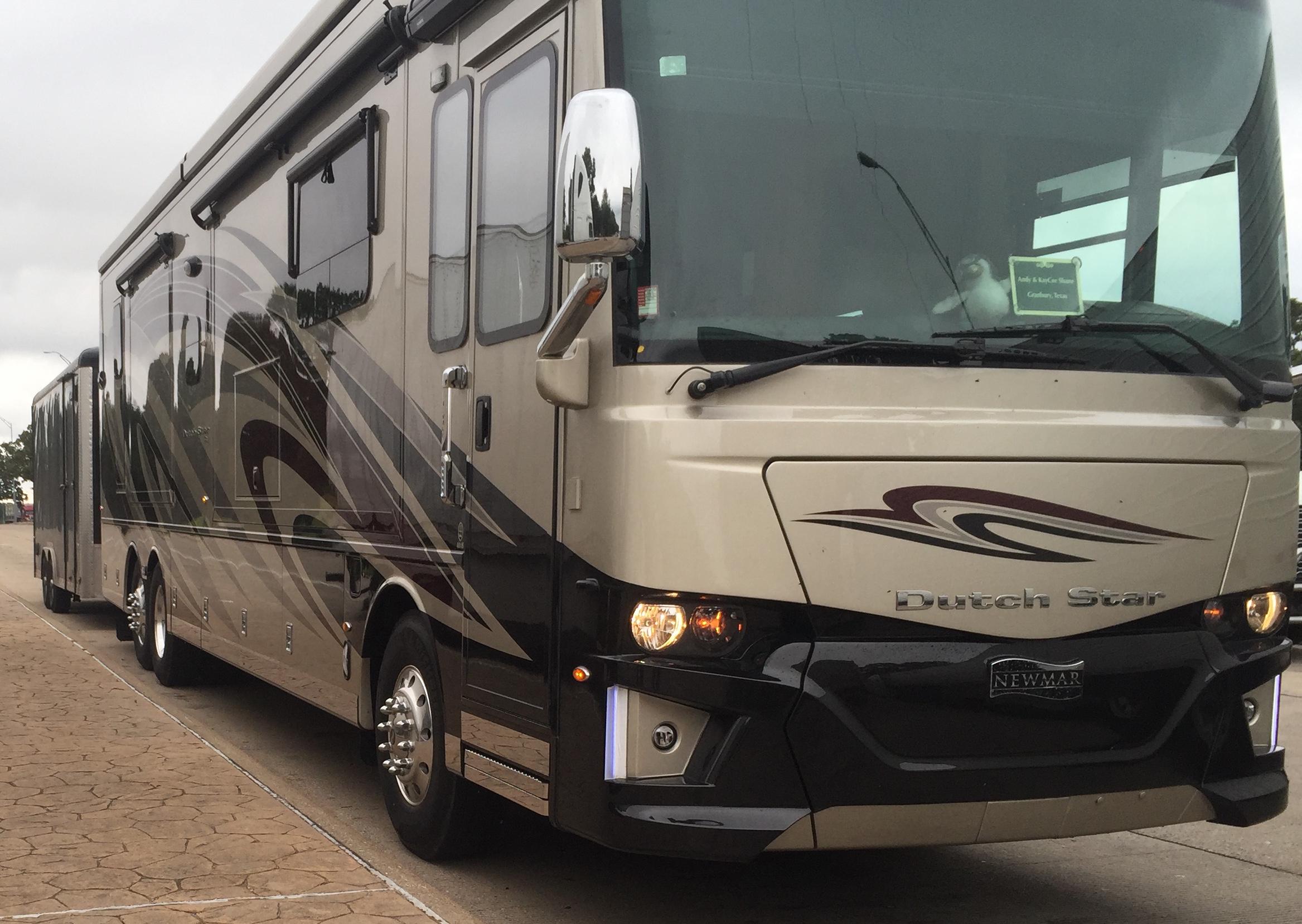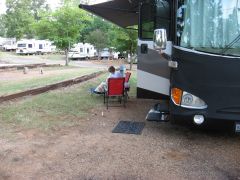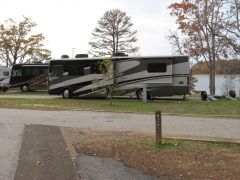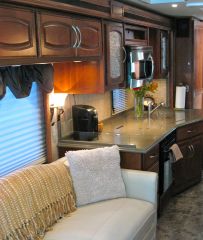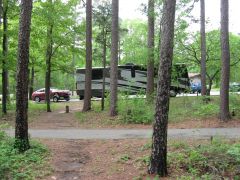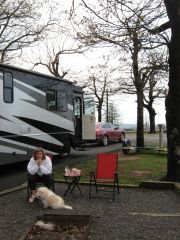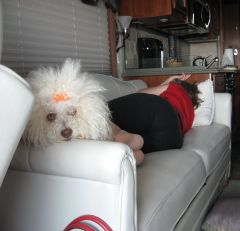-
Content Count
257 -
Joined
-
Last visited
-
Days Won
4
Content Type
Profiles
Forums
Blogs
Gallery
Everything posted by andyshane
-
There is a volume dealer in the vicinity you mention that has had a couple of offerings with things like duct-taped headlights, corrosion layered over with undercoating, etc found on their lot. Not sure if these items were performed by the dealer from whom they purchased, or in their own shops. In any case, as always, be careful. 'Just checked with a private dealer, he's not heard of a professional inspector in that area.
-
Man, did we ever talk this to death in the other forum... Here, too. We have some great tire expertise at FMCA, they'll be joining us shortly. The consensus is to err high when deciding which psi to use, for a host of reasons. I'll touch on a couple, our friends will add some more. While we should never get to the far right edge of the chart, remember not to inflate over that figure (also stamped on the sidewall). As a personal technique, on both RVs and my aircraft, I try to inflate once the outside/shop temp is about 65F. The important thing is, inflate them "cold" (before driving more than a mile, says Michelin). For safety, many manufacturers recommend using a locking chuck with the gauge mounted at the other end of a long hose (mine is five feet). I believe the consensus of most tire manufacturers is, if you have to put 20 psi or more in, the tire is considered a "run-flat" and must be inflated by a professional with the right tools (it can kill you, inflating it). First, nobody knows your loading as well as you; but, we all run the chance of having a bit more weight on one side than the other. To that end, let's pick out a weight slightly higher than half of the scale readings to arrive at a worst-case axle-end weight. For example, if we toss in another 10% in the case of the steer axle, that brings you to 7,227 lbs, or 110psi. For those of us who haven't done axle-end weighing, establishing an assumed axle-end weight that includes a surplus for lateral imbalance is a good safety technique. As we talked about recently here, some experts also suggest adding a bit of extra pressure for the forgetfulness factor: if your tires lose a bit of pressure between checks, you're covered. Whether you wish do to this or not, depends on your own maintenance habits. So, you might hear folks tell you to bring the steer tires up to 115. Of course, surplus can come in two forms: pressure you add above and beyond the manufacturer's recommended value, and that which the table gives you by virtue of where you fall in the weight category. Such would be the case with your tag: I'd accept the difference between 4,270 lbs and the table's 5,375 as all the margin you need, inflate them to 75 psi. Not lower, since the tire was not tested/certified at less than 75. One thing I like to do: get a little IR scanner to gage the temp of your tires, at each safety check. If the temps go much over 120F, consider adding a little air. Scanning with sun on the tire might give a false high reading, base your action over several checks. More guidance from Michelin is HERE.
-
We just put several hundred miles in the span of three months on a TireTraker, good performance. Interestingly, I haven't yet mounted the signal booster; yet, we get signals from the dolly and toad. Very valuable, since usually the first sign you'll have the a dolly tire has failed is light-flashing/waving/horn-blowing from other motorists. One slight problem: a sender stopped transmitting on the first trip, I noticed that a battery bracket leg had become detached, offered to solder it in my shop, if the company approved the procedure. They said "No," and had one in the mail minutes later, with a pre-paid envelope enclosed for free return. Two observations: the temp-sensing function of stem-mounted senders is as worthless as mounting an ashtray on a motorcycle. Make sure you shoot tire surface temps with an IR gun to affirm proper inflation*; and, a good trick is to measure tire pressure at 70F after the rig has sat overnight, use several different gages to refine inflation to the exact value mandated by the TIRE manufacturer. Then, climb into the driver's seat and make a list of the pressures shown on the TPMS. We printed a little card, that stays in the cockpit. Those numbers, not the gage-verified mandated inflation, are what you should see, at the start of a day's driving. Of course, we all know that the pressures will increase underway, and that we never bleed air from hot tires... (A question on your CDL test, in some states). * Tire surface temps over 120F suggest the need for more inflation. Caution: Shooting tires on the sunny side of the coach can result in a false elevated reading. Fodder for the Never Again Collection, from yesterday's 80 mile drive: Traversing construction in the awful and perennially beat-up west side of Weatherford, Texas, we approached an intersection in which our side had narrowed to one lane bordered on the right by a concrete barrier. The light was three cars ahead, and opposing road slightly offset to the left. As a result, when the light turned green, traffic crossing from the right saw they wouldn't be able to make a right turn on red and stopped well short of the intersection, allowing us a wide swing to get the toad around the barrier making the 90 degree right turn the GPS demanded. I cleared to the left and hugged the left side of my narrow lane to start the swing, and suddenly noticed the lead vehicle halted to the right had moved forward into the intersection!! Predictably, the line behind him immediately closed the gap. Rather than abort and opt for the straight-through track, I swung within ten inches of his fender, crawled forward to assure the dolly and toad didn't catch the barrier... The moral of the story is to have the right-seater call out such an intrusion, teamwork that might one day prevent one of those dreaded traffic-blocking episodes we all have nightmares about. As my Prevost-owning neighbors attest, removing a toad amidst changing lights and a blaring symphony of horns is not fun.
-

Owning A Motorhome: Depreciation vs. Appreciation
andyshane replied to tmoning's topic in Buying an RV
I don't know what avgas is there, Bruce, but we're paying $4.70 wholesale. We both (ours is a '53 Cessna 180) cruise at about 10 gal per hour. So, the planes use the same amount of gas as the MHs, but cost more to fill up. While they generally appreciate albeit slightly, contrary to our depreciating coaches, small aircraft still lose to RVs since you have to rent cars, go to restaurants, get hotel rooms with the plane. We too have happily traded small plane travel for RVing, and haven't looked back. -
A good lead-in for my shameless product promotion of the year: the folks at Temp Gun have been wonderful to me, just sent us a new unit and carrying case gratis only because my ten year old PE-1* was showing an error code none of us could figure out. This is the perfect tool for RV'ers interested in taking tire safety to the next level: on hourly safety stops, I "shoot" all the tires and brakes. Heat buildup is a harbinger of tire pressures that are low for the load. A 120F max tire temp affirms correct inflation regardless of tables, axle-end weights, etc. The curative effect of just a few psi in response to an elevated temp is impressive. * Purchased for doing aircraft fabric repair, where precise iron calibration is a matter of life and death. Well... ugly fabric versus a decent job. I'd begun using it when we started RV'ing and found it to be the perfect solution for temp-sensing on the road, flawlessly accurate and not much bigger than a Bic lighter. One-button operation, auto-shutoff, no contact with the sensed surface and $30 price make it a best value.
-
Hear, hear! And, the little things are those generally that each of us can detect, if not control. I highlighted the part of your response instrumental to all of us, doing our Pre-Trip Inspections. Herman, I was leaning in that direction, called Spartan to confirm my decision. Even then, I cleaned and purged then inspected each close-up. Even then, they'll each get a lot of attention from here on. Thanks for the thumbs-up, all: the wife and a girlfriend (hers) are next up for a 400 mile trip (I'm in recurrent training then), I want them to be safe. (Thanks, Dwight! Hey, that's my middle name. 'Born to college students, to smooth the way Mom and Dad named me after each grandfather.)
-
I noticed during a check of the front suspension that my tie rod end boots were tattered. There was lots of grease around them, fortunately. On the advice of MH owner friends, I just dropped my tie rod, glued on universal boots purchased for $8 from the auto parts store. It required a Pittman Arm Puller, the larger size, loaned from the store. And, an impact wrench was required to break loose the castellated nut, re-torque it to the specified 250 in lbs setting. The new boot doesn't have the stiff ring molded into the upper edge, but has a thicker wall than the notoriously flimsy stock items. According to Spartan, if the boot has been broken for an unknown period, the tie rod end must be replaced. Their technical manuals have specifications for assessing wear that necessitates replacement. Since mine were both tight and encased in grease; so, I repacked them, and returned to service. I just came in from a test drive minutes ago, and all seems well. Pictures are at my online Picasaweb album HERE.
-

Owning A Motorhome: Depreciation vs. Appreciation
andyshane replied to tmoning's topic in Buying an RV
I couldn't say it better myself. Look at the model Kane and Susan own, too. That speaks volumes. They reached back seven model years, I'll bet got a lot of bang for the buck. For us, if the airline biz doesn't totally crash & burn, we're hoping to buy a 2009 42 KFQ Monaco or equivalent. It'll have ended the freefall portion* of its depreciation, yet be new-feeling and have the features we want. The NADA book says that every six months we wait, it settles another $10K. Wow. * After five or six years, depreciation should settle in at 3-4% per year. -
I just got my Texas Class B, the wife and a fellow MH driver buddy are dragging their feet but will eventually follow suit. Really, it was no trouble. The examiner relished every moment of being away from her spot behind the counter, we had a great time. Now, I don't have the specter of not being in compliance hanging over my head. While claim denial is unlikely, the attorney watering flowers on the patio behind me says that it is within the insurance company's rights to deny the claim.
-
Okay, that does it for me. Thanks for the singular best post I've read among thousands. You've affirmed the course of action I'll take from here on, when it comes to tire safety.
-
Super suggestions; we might add tank quantity high or low to the list of "whens." Our graywater system will belch into the coach four or five gallons from being full. At all other times, you can't smell a thing. It's a very handy tool, but was a bit confusing at first. (BTW, if you can't smell the blackwater tank when flushing with the bathroom fan turned on, you might have a plugged vent.)
-
The wife and I talked about this, shared some memories of one town in NE Texas where we seemed to catch every red light. After two or three jarring stops, I "parked" in the slow lane at a little under the speed limit, life got easier. It's not too hard to spot these units. I see their red light camera and raise them a 15-ton rolling speedbump
-
I too am learning, eager to come up with good answers. The tech team at Michelin got back to us with the following quote (I highlighted "correct"): The amount of air pressure required in each tire on an RV depends on the weight of the fully loaded vehicle. Therefore, the RV has to be weighed loaded by individual wheel position. Correct procedure on weighing the RV can be found in our RV Tire Guide under "How To Weigh The Recreational Vehicle". Once the actual corner loads are known, the correct air pressures can be determined. Use the RV load and inflation table (http://www.michelinrvtires.com/michelinrv/toolbox/reference-material.jsp ) to establish the air pressure for the heaviest side of the RV. Match the opposite tire(s) across the axle with the same pressure. It is acceptable to add a small amount of additional pressure as a safety margin. Salient to this, is that users can define "margin" first, eg outright extra psi or the difference between their axle-end weight and that allowed in their chosen table block; then, they can decide what is appropriate to their pressure-checking and loading habits. In my own case, given that I manually check my tires each trip to within 2 psi of optimum, and have virtually no load variance, that my tire wear is perfect and there exists a few hundred pounds per axle-end surplus until the next higher value is called for, I'll stick with the table. For the average user, however, I think the technique of going 5 psi over the table value is probably good insurance. Special thanks to Michelin HQ for weighing in on this one. Given the hundreds of user reports floating around out there in various forums, it is obvious that Michelin is indeed the current best choice, for RV owners.
-
Good point. If you're lucky enough to have a power washer with a "Delicate" tip, it might be okay: vigilance and a little common sense is the key.
-
I did the all routine stuff, then noticed that the fan blades felt gummy... Sure enough, my regular pressure washing (using Delicate tip for radiator halves, of course) after applying copious degreaser wasn't doing the trick. It took an hour of scrubbing with degreaser and a stiff-bristled brush, reaching down through the bedroom closet floor, to get those blades looking pretty... One thing I'll do more of this season: pull my speed back and downshift to increase my rpm, when the temp creeps over 200F. "Understanding Coach/RV Performance" is a publication distributed by Caterpillar, they briefly address cooling in the C7 engine.
-

Debating Dolly Against Tow Bar, And Need Help
andyshane replied to DavDona's topic in Toads-Towed Behind Motorhome
We've had two dollies (one borrowed to test the concept and then the one I bought), think it is the most economical way to go. Now, after some 30 overnights, we've yet to find a place where the dolly was a hassle. The worst case I encountered was at the ABQ Balloon Fiesta, where I had to march it 50 yards to the fence line, lock it, leave it with others. My hookup and takedown time is equal to a 4-down person; one of us has to bend over and hook up the safety chains. One day, that might knock us out of the running; but, for now, no sweat... Something else that might propel you into 4-down: storage when not traveling. I've got 3,600 feet of garage floor, at home, so it's not a problem. -
Thanks, Mr. B! Maybe Michelin has rolled that value into their RV tables, eg the note is absent. Indeed, lots of Goodyear owners have cupping problems. My next door neighb at the ABQ Balloon Fiesta in October showed me his Goodyears, marked cupping on his steering tires. His tires had half the miles on them I had on ours. It makes sense to add pressure for that: shifts the load towards the center of the tire. 'Sure be nice to know if cupping sufferers also had higher temps, before they upped the psi. BTW, my tires need air no more frequently with TireTraker than without the sensors. I wonder if valve core depth has an effect, eg if the core is set just above the threshold for conveying pressure to the sensor it'd be less prone to leak... I don't know.
-
I've enjoyed reading the thread, take an interest in tires. 'Will tell you what I've been doing, hope you can point me to something written by either the manufacturers of the Natl Hwy Tfc Safety Admin about adding a safety margin. 'Never heard that term before, want to learn more about it. First, someone was talking about Michelin data pertaining to total axle weight; I was prompted to dig out my guide and re-read the introduction from the tire manufacturer. For RV use only, Michelin displays tire loads per axle end in theload and inflation tables, as we recommend weighing each axleend separately and using the heaviest end weight to determinethe axle's cold inflation tire pressure. I highlighted the operative term that caught my eye. If my math is correct, that gives you a margin of a total front axle weight up to 11,380 lbs on 90 psi. True, some of the company's tire charts refer to total axle weight; but, my RV table deals with axle-end. After re-reading my Michelin stuff and the NHTSA guidelines, I keep coming up with the inflation table values as "recommended" rather than "minimum," and would like to hear if I've been under-inflating mine. All my crosschecks suggest that inflating to the recommended value for the rounded-upward heaviest axle-end weight is optimum for the tire itself: I've been running 85 psi in my 275/70R22.5 LRJ XZE2 Energy model with 7,000 miles of decent handling, perfect tread wear distribution and a peak running temp (IR scan, not stem temp) of 120F. Any additional information is greatly appreciated. Super thread!
-
This is why I routinely scroll through all my tire pressures on the TPMS as part of my preflight. I'm interested in your comment about adding 5psi. Not objecting to the practice, since it is definitely not a safety problem; but, the engineers came up with those table pressures to give (for one) optimum contact patch, and it seems odd that a company rep would advocate essentially reducing customers' traction (albeit a tiny amount)... I'm fully prepared to add 5 or 10 psi if a tire ends up hotter than 120F at a safety check. But, to date, adhering to Michelin tables exactly has produced 120F running temp on the hottest days; so, no need to reduce temps with extra pressure. Industry consensus is that we should never let our tires go above 180F.
-
Thanks for the catalog links! For those of us with indoor shops, this can be an Intermediate DYI project. My current avg is about 4 manhours per window, operating solo.
-
-
From the album: Andy & KayCee's Fleetwood Excursion
Nobody told us what the singular best aspect of RV'ing is H a p p y H o u r ! (Picture taken 4th of July weekend at Palestine Pines park in Flint, Texas. Not an ideal place, lots of fulltimers and 80's vintage trailers, but some of the nicest people you'll ever meet. The young owner works harder, has longer hours, than any other human on Earth.) -
Hello again, SeaJay. I hope you're doing okay, know it has been a difficult year. Here's your info. Captain Norris D. "Andy" Shane, USAF 1978-1988 Instructor Pilot, KC-135A 7AREFS, Carswell AFB, Texas Eldorado Canyon, 1986 (Small potatoes compared to TSgt Norris D. Shane, 1927-2007, 1943-1946 US Navy; 1947-1977 US Air Force, Normandy, 1944. His plaque is on the wall among thousands of veterans' at The National Museum of the Pacific War in Fredericksburg. My beloved Uncle Dave thought it was a big deal, me going to pilot training, flying; despite his persistent habit of getting busted in rank, I'd consider his career the stellar one. Still healthy and robust at 81, the undisputed heart throb of his retirement complex, he was unexpectedly felled by a heart attack.)
-
From the album: Andy & KayCee's Fleetwood Excursion
Another lovely state park! -
From the album: Andy & KayCee's Fleetwood Excursion
Fleetwood decor is noteworthy, provides a lot of style for the dollar. This is a 2005 entry-level diesel pusher with 90,000 miles!

